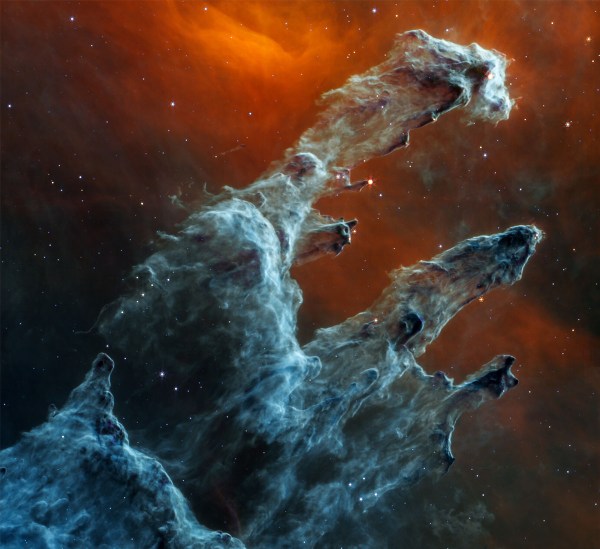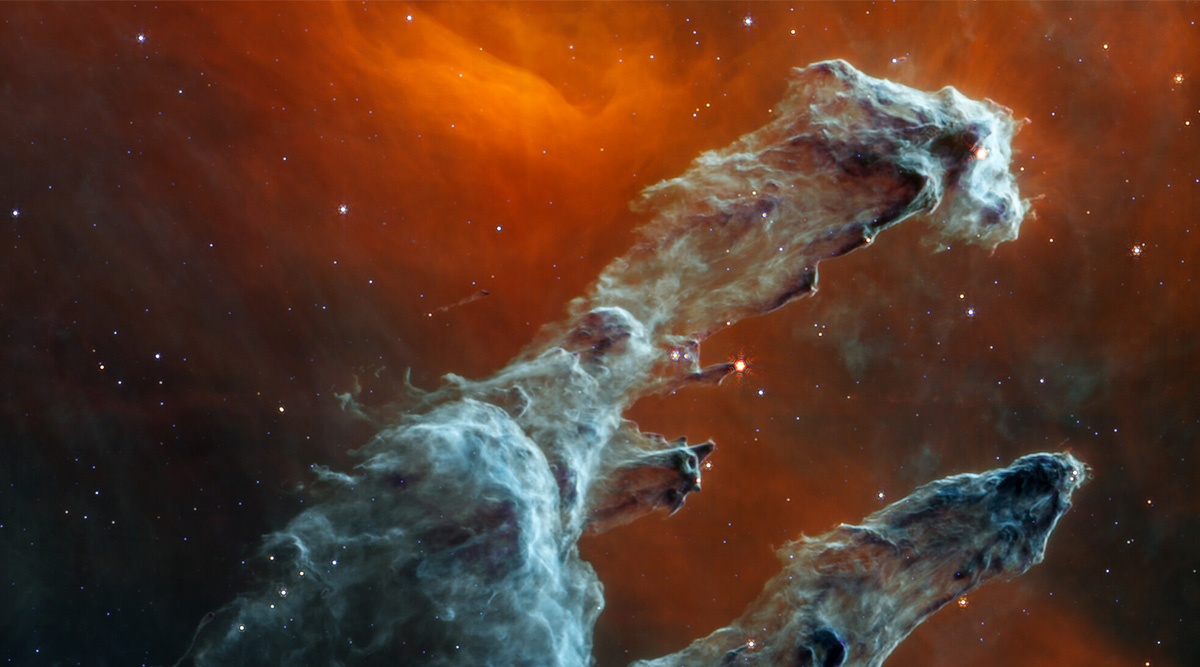This is not an illustration of dementors from the Harry Potter universe, nor is it a digital artist’s imagination of what spirits look like. This is actually an image of the pillars of creation—clouds of interstellar gas in the Eagle Nebula—captured by the James Webb Space Telescope in the mid-infrared spectrum.
These pillars were first catapulted into fame in 1995 when it was captured by the Hubble Space Telescope. Webb had earlier captured an image of the pillars of creation rendered in the near-infrared spectrum, giving more clarity and detail than the Hubble image. But this image, captured in mid-infrared light, gives an almost eerie view of what is a familiar landscape.
Pillars of creation in mid-infrared light
Webb’s Near-Infrared Camera (NIRCam) image of the pillars of creation shows thousands and thousands of stars forming in the region. But many of these stars are missing in this MIRI (mid-infrared instrument) image. According to the European Space Agency, this is because many of the newborn stars no longer have “cloaks” of dust that can be detected in mid-infrared light.
1/ This video shows three views of the Pillars of Creation captured by @HUBBLE_space & Webb #BFFinSpace
Read more: https://t.co/yLdN5ei0LN pic.twitter.com/qxTdo3oNer
— ESA Webb Telescope (@ESA_Webb) October 30, 2022
MIRI is only able to see the stars that still have their “cloaks” on. That is what the red orbs near the borders of the pillars are. The blue dots that are scattered through the scene, however, are ageing stars that have shed off most of their gas and dust.
 James Webb Space Telescope’s MIRI image of the pillars of creation is missing many of the stars that can be seen in other images. (Image credit: NASA, ESA, CSA, STScI, J. DePasquale (STScI), A. Pagan (STScI))
James Webb Space Telescope’s MIRI image of the pillars of creation is missing many of the stars that can be seen in other images. (Image credit: NASA, ESA, CSA, STScI, J. DePasquale (STScI), A. Pagan (STScI))
MIRI’s party trick is its excellent ability to reveal gas and dust in great detail. The darkest shades of grey in the image represent the densest areas of light. The red region at the top, which seemingly forms the shape of a bird with outstretched wings, is where the dust is cooler and more diffused.
Also, this image is curiously devoid of any background galaxies. This is because the densest part of the Milky Way’s disc has too much gas and dust to allow light from distant galaxies to pass through.
!function(f,b,e,v,n,t,s)
{if(f.fbq)return;n=f.fbq=function(){n.callMethod?
n.callMethod.apply(n,arguments):n.queue.push(arguments)};
if(!f._fbq)f._fbq=n;n.push=n;n.loaded=!0;n.version=’2.0′;
n.queue=[];t=b.createElement(e);t.async=!0;
t.src=v;s=b.getElementsByTagName(e)[0];
s.parentNode.insertBefore(t,s)}(window, document,’script’,
‘https://connect.facebook.net/en_US/fbevents.js’);
fbq(‘init’, ‘444470064056909’);
fbq(‘track’, ‘PageView’);






